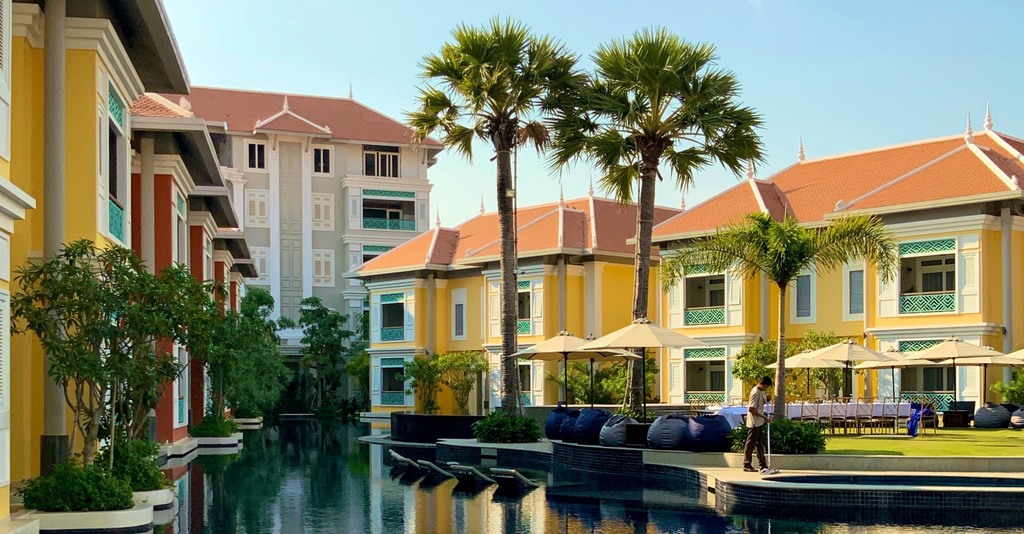April 19, 2023
By Duyen Ha Vo, Tram Dang and Nhung Trinh, VILAF Vietnam’s slow real estate market has been given a ray of hope with the recent release of Decree 10/2023/ND-CP and the ongoing review of a proposed amendment to the Law on Real Estate Business. These new legal measures aim to create a more transparent legal framework for the development of condotels and resort villas, which complements the regulations provided by Decree 02/2022/ND-CP released last year. This article provides an overview of the legal framework for the development of condotels, resort villas, and other similar commercial properties after the new legislative instruments take effect. Here are the key points to note: Developers of condotels, resort villas, and officetels in a properly licensed non-residential project on commercial land are allowed to sell such properties as a real estate business. Buyers of condotels and resort villas can obtain Pink Books for such properties, but the eligibility of officetels for Pink Books is still uncertain. As the land for developing condotels and resort villas must be commercial land, the land use term under the Pink Book granted to a buyer is restricted to the commercial land use term awarded to the developer, which is up to 50 years (or 70 years in specially approved cases). The sale of condotels and officetels must adopt the statutory contract template provided in Decree 02/2022/ND-CP. The draft Amended Law on Real Estate Business and the new decrees do not explicitly refer to shophouses. The concepts Under the tourism laws, a “condotel” (căn hộ du lịch) and a “resort villa” (biệt thự du lịch) (collectively, “lodging properties”) are... March 29, 2023
1. Background and context of e-commerce in Vietnam Online transactions are usually trivial, and dispute settlement, e.g., through mediation, arbitration, civil court, etc., costs time and money. This would prompt consumers to let it go, or spread warnings over the web as widely as possible, expecting this to serve as a deterrence to dishonest vendors. After all, who would give up a whole working day just to seek justice for, let’s say, a damage worth VND30,000 (USD1,2)? But supposing a thousand consumers, instead of just one, become victims, the dishonest vendor will in this case acquire an illicit gain of VND30,000,000 (~USD1,200) without moving a finger. Bearing in mind that the revenue generated by the Vietnamese retailer e-commerce was predicted to reach USD16.4 billion in 20221, and will grow exponentially in the following years, such illicit gain would increase tremendously if the customers persist in reacting passively. And this is where consumer protection laws are supposed to come forward. 2. A glance at claimable damages under Vietnamese consumer protection laws First of all, consumer protection laws come forward with damage compensation regimes. From the standpoint of Vietnamese legislatures, compensation for damages resulting from violation of consumers’ interests is based on both contractual and non-contractual obligations. The relationship between consumers and vendors is contractual and reciprocal at the very essence. Vendors accordingly must ensure that the goods are delivered in the quantities and quality as promised to the consumers under a sale of goods contract. Where the vendors fail to do so, they are deemed to have breached the contract and thus are obligated to compensate for damages as per... March 28, 2023
The amendments to the Civil and Commercial Code (“CCC”) will come into effect on 7 February 2023, after being published in the Government Gazette on 8 November 2022. (please click HERE for more information). One of the key changes pertains to the requirement for publishing notice of a shareholder’s meeting. The new amendment eliminates the requirement for a newspaper publication, except in cases where share certificates are issued to bearers that the newspaper publication, either physical or electronic, is still required. The Department of Business Development (“DBD”) has clarified the publication requirement for notice of a shareholder’s meeting under the new amendments on its website. According to the clarification, if the articles of association (“AOA”) of a company that issued only named share certificates specify a requirement for newspaper publication according to the existing CCC provision before the amendments to the CCC, the company must still require a newspaper publication according to its AOA. If the company wishes to eliminate such requirement, it must prior amend the articles relating to such requirement in its AOA to align with the CCC amendments. As the amendment to the AOA must be approved by the shareholder’s meeting, the company may consider amending its AOA immediately after the effective date of the amendments to the CCC, or it may continue the current practice until the next scheduled shareholder’s meeting; for example, the next annual general meeting of shareholders within April 2023 for companies with a financial year ending 31 December 2022. Authors: Peangnate Sawatdipong Bio: Peangnate is a Partner at Chandler MHM Ltd. (CMHM) and has been with the firm since 1985. She... March 24, 2023
With the lifting of activity and capacity restrictions as well as masking and stay-at-home mandates in the Philippines in 2022, the country experienced a flurry of economic activity that drove growth to 7.6%, breaching official forecasts. The economy is expected to follow a steady growth trajectory in 2023 with projected gross domestic product (GDP) growth of 6% to 7%, significantly higher than the global GDP growth forecast. Considering several landscape-changing legislative and regulatory reforms passed in 2022 that are designed to attract muchneeded capital and technology from foreign investors, certain sectors and industries are well-placed to benefit from foreign direct investments (FDIs) into the Philippines in 2023 and beyond. Renewable Energy A convergence of significant tailwinds serve to boost the renewable energy sector as one of the most compelling opportunities for FDIs in the Philippine at present: the government’s push for energy security and commitments towards sustainability and a green economy, the abundance of resources naturally available in the tropical archipelagic state of more than 7,000 islands, the generous fiscal and non-fiscal incentives that can be availed of under the Renewable Energy Act, and the recent easing of nationality restrictions that previously suppressed growth in this sector. Through the Department of Energy (DOE) Department Circular (DC) No. 2022-11-0034 which took effect on 8 December 2022, the restriction for a Renewable Energy Service/ Operating Contract (RE Contract) to be awarded only to Filipinos or corporations at least 60% owned by Filipinos has effectively been removed. This amendment is a welcome development directed to help achieve the country’s ambitious target of a 35% renewable energy share in the power generation mix by... March 24, 2023
Market scandals and the evolution of the regulatory regime for the financial markets have been among the most discussed topics in Vietnam in 2022 and early 2023. Regulators have issued new regulations in 2022 and are considering draft regulations to further adjust the market, protect investors, and simplify administrative procedures. This article provides an overview of the current legislative changes that are impacting the financial markets in Vietnam. Highlights In September 2022, the Government issued Decree 65 on corporate bonds to tighten the eligibility criteria for natural persons to be considered “professional securities investors” and to increase transparency in the bond market by adding more detailed requirements for the offering dossier, offering plan, and public disclosure. However, a draft regulation is currently being considered to postpone the effective date of some of the requirements under Decree 65 until the end of 2023. . In September 2022, the State Bank of Vietnam (SBV) issued Circular 10 and Circular 12 to replace existing regulations on foreign exchange requirements for foreign currency bond transactions and offshore borrowing transactions. These circulars simplify procedural requirements by providing exemptions for amendment registrations in certain circumstances. Circular 12 also extends the grace period for the registration requirement for short-term borrowings from 10 days to 30 days from the expiration of the initial one-year tenor. Additionally, a new section on security transactions is introduced, outlining a foreign exchange regime for security enforcement in connection with offshore borrowings. The only aspect where there is an increase in administrative requirements is the monthly submission of reports on foreign borrowing performance status to the SBV by borrowers, instead of quarterly reports as... March 22, 2023
To improve energy conservation in buildings across Thailand, in 2020, the Minister of Energy issued the Ministerial Regulation Prescribing Type or Size of Building and Standard, Criteria and Procedure in Designing Building for Energy Conservation B.E. 2563 (2020) (the “Ministerial Regulation”) by virtue of the Energy Conservation Promotion Act B.E. 2535 (1992). On 27 December 2022, the Building Control Committee issued the Notification of the Building Control Committee Re: Enforcement of the Ministerial Regulation Prescribing Type or Size of Building and Standard, Criteria and Procedure in Designing Building for Energy Conservation B.E. 2563 (2020) in the Building Control in accordance with the Building Control Laws (the “Notification”) to impose the Ministerial Regulation as requirements under the building control law. Effective from 25 January 2023, it is mandatory for certain types of buildings, i.e., entertainment halls, hotels, entertainment establishments, medical facilities, educational institutes, office or business buildings, shopping malls or department stores, condominiums, and public assembly buildings, to comply with energy efficient design in order to obtain a construction license, a building modification license, or a certificate of construction under the Building Control Act B.E. 2522 (1979) (as amended). As part of the application for a construction license, building modification license, and construction certificate, a building owner is required to prepare an assessment report relating to the building’s energy conservation design. Energy efficient design includes the building facade, lighting system, air-conditioning system, and water heating equipment within the building. Although the Notification is effective as of 25 January 2023, under the Ministerial Regulation, a building with a gross floor area of 2,000 square meters or more, but less than 5,000... Upcoming Events
Recent Past Events
















